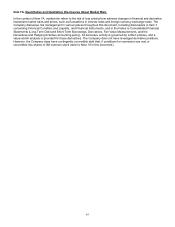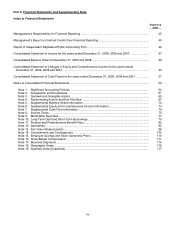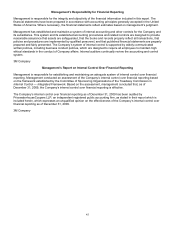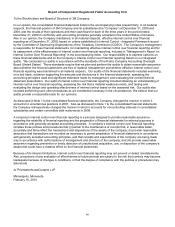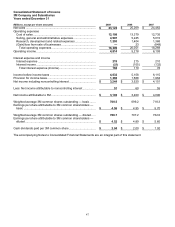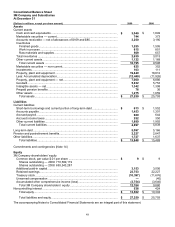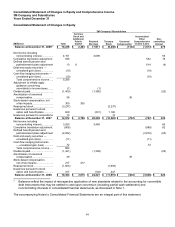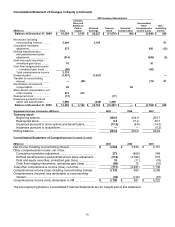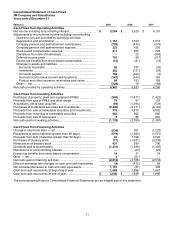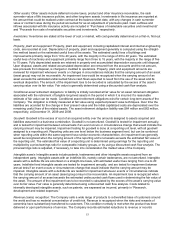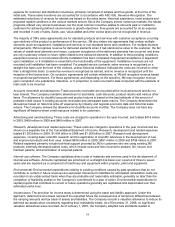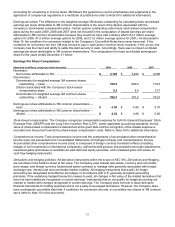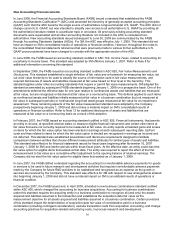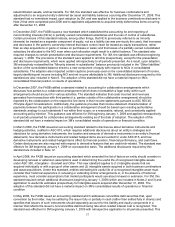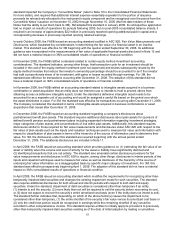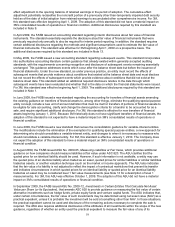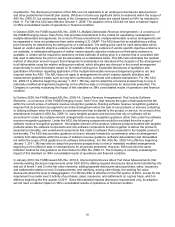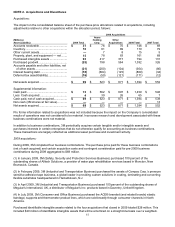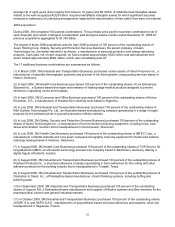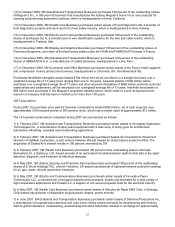3M 2009 Annual Report Download - page 59
Download and view the complete annual report
Please find page 59 of the 2009 3M annual report below. You can navigate through the pages in the report by either clicking on the pages listed below, or by using the keyword search tool below to find specific information within the annual report. 53
Other assets: Other assets include deferred income taxes, product and other insurance receivables, the cash
surrender value of life insurance policies, and other long-term assets. Investments in life insurance are reported at
the amount that could be realized under contract at the balance sheet date, with any changes in cash surrender
value or contract value during the period accounted for as an adjustment of premiums paid. Cash outflows and
inflows associated with life insurance activity are included in “Purchases of marketable securities and investments”
and “Proceeds from sale of marketable securities and investments,” respectively.
Inventories: Inventories are stated at the lower of cost or market, with cost generally determined on a first-in, first-out
basis.
Property, plant and equipment: Property, plant and equipment, including capitalized interest and internal engineering
costs, are recorded at cost. Depreciation of property, plant and equipment generally is computed using the straight-
line method based on the estimated useful lives of the assets. The estimated useful lives of buildings and
improvements primarily range from 10 to 40 years, with the majority in the range of 20 to 40 years. The estimated
useful lives of machinery and equipment primarily range from three to 15 years, with the majority in the range of five
to 10 years. Fully depreciated assets are retained in property and accumulated depreciation accounts until disposal.
Upon disposal, assets and related accumulated depreciation are removed from the accounts and the net amount,
less proceeds from disposal, is charged or credited to operations. Property, plant and equipment amounts are
reviewed for impairment whenever events or changes in circumstances indicate that the carrying amount of an asset
(asset group) may not be recoverable. An impairment loss would be recognized when the carrying amount of an
asset exceeds the estimated undiscounted future cash flows expected to result from the use of the asset and its
eventual disposition. The amount of the impairment loss to be recorded is calculated by the excess of the asset’s
carrying value over its fair value. Fair value is generally determined using a discounted cash flow analysis.
Conditional asset retirement obligations: A liability is initially recorded at fair value for an asset retirement obligation
associated with the retirement of tangible long-lived assets in the period in which it is incurred if a reasonable
estimate of fair value can be made. Conditional asset retirement obligations exist for certain long-term assets of the
Company. The obligation is initially measured at fair value using expected present value techniques. Over time the
liabilities are accreted for the change in their present value and the initial capitalized costs are depreciated over the
remaining useful lives of the related assets. The asset retirement obligation liability was $64 million and $62 million,
respectively, at December 31, 2009 and 2008.
Goodwill: Goodwill is the excess of cost of an acquired entity over the amounts assigned to assets acquired and
liabilities assumed in a business combination. Goodwill is not amortized. Goodwill is tested for impairment annually,
and is tested for impairment between annual tests if an event occurs or circumstances change that would indicate the
carrying amount may be impaired. Impairment testing for goodwill is done at a reporting unit level, with all goodwill
assigned to a reporting unit. Reporting units are one level below the business segment level, but can be combined
when reporting units within the same segment have similar economic characteristics. An impairment loss generally
would be recognized when the carrying amount of the reporting unit’s net assets exceeds the estimated fair value of
the reporting unit. The estimated fair value of a reporting unit is determined using earnings for the reporting unit
multiplied by a price/earnings ratio for comparable industry groups, or by using a discounted cash flow analysis. The
price/earnings ratio is adjusted, if necessary, to take into consideration the market value of the Company.
Intangible assets: Intangible assets include patents, tradenames and other intangible assets acquired from an
independent party. Intangible assets with an indefinite life, namely certain tradenames, are not amortized. Intangible
assets with a definite life are amortized on a straight-line basis, with estimated useful lives ranging from one to 20
years. Indefinite-lived intangible assets are tested for impairment annually, and are tested for impairment between
annual tests if an event occurs or circumstances change that would indicate that the carrying amount may be
impaired. Intangible assets with a definite life are tested for impairment whenever events or circumstances indicate
that the carrying amount of an asset (asset group) may not be recoverable. An impairment loss is recognized when
the carrying amount of an asset exceeds the estimated undiscounted cash flows used in determining the fair value of
the asset. The amount of the impairment loss to be recorded is calculated by the excess of the asset’s carrying value
over its fair value. Fair value is generally determined using a discounted cash flow analysis. Costs related to
internally developed intangible assets, such as patents, are expensed as incurred, primarily in “Research,
development and related expenses.”
Revenue (sales) recognition: The Company sells a wide range of products to a diversified base of customers around
the world and has no material concentration of credit risk. Revenue is recognized when the risks and rewards of
ownership have substantively transferred to customers. This condition normally is met when the product has been
delivered or upon performance of services. The Company records estimated reductions to revenue or records


